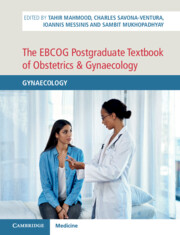Book contents
- The EBCOG Postgraduate Textbook of Obstetrics & Gynaecology
- The EBCOG Postgraduate Textbook of Obstetrics & Gynaecology
- Copyright page
- Dedication
- Contents
- Videos
- Contributors
- Preface
- Section 1 Basic Sciences in Gynaecology
- Section 2 Menstrual Disorders
- Section 3 Reproductive Endocrinology and Infertility
- Section 4 Contraception and STIs
- Section 5 Post-Reproductive Care
- Section 6 Vulva and Vagina
- Section 7 Cervix
- Section 8 Uterus
- Section 9 Ovary and Fallopian Tubes
- Chapter 37 Childhood Ovarian Cancers
- Chapter 38 Benign and Borderline Ovarian Tumours
- Chapter 39 Non-epithelial Ovarian Cancers
- Chapter 40 Diagnosis of Epithelial Ovarian, Fallopian Tubal and Peritoneal Surface Cancers
- Chapter 41 Treatment of Epithelial Ovarian Cancers, Fallopian Tube Cancers and Peritoneal Surface Cancers
- Chapter 42 Benign Breast Disorders
- Section 10 Operative Gynaecology
- Section 11 Public Health Issues in Gynaecology
- Section 12 Miscellaneous
- Index
- Plate Section (PDF Only)
- References
Chapter 38 - Benign and Borderline Ovarian Tumours
from Section 9 - Ovary and Fallopian Tubes
Published online by Cambridge University Press: 24 November 2021
- The EBCOG Postgraduate Textbook of Obstetrics & Gynaecology
- The EBCOG Postgraduate Textbook of Obstetrics & Gynaecology
- Copyright page
- Dedication
- Contents
- Videos
- Contributors
- Preface
- Section 1 Basic Sciences in Gynaecology
- Section 2 Menstrual Disorders
- Section 3 Reproductive Endocrinology and Infertility
- Section 4 Contraception and STIs
- Section 5 Post-Reproductive Care
- Section 6 Vulva and Vagina
- Section 7 Cervix
- Section 8 Uterus
- Section 9 Ovary and Fallopian Tubes
- Chapter 37 Childhood Ovarian Cancers
- Chapter 38 Benign and Borderline Ovarian Tumours
- Chapter 39 Non-epithelial Ovarian Cancers
- Chapter 40 Diagnosis of Epithelial Ovarian, Fallopian Tubal and Peritoneal Surface Cancers
- Chapter 41 Treatment of Epithelial Ovarian Cancers, Fallopian Tube Cancers and Peritoneal Surface Cancers
- Chapter 42 Benign Breast Disorders
- Section 10 Operative Gynaecology
- Section 11 Public Health Issues in Gynaecology
- Section 12 Miscellaneous
- Index
- Plate Section (PDF Only)
- References
Summary
This chapter will explore the pathophysiology, clinical presentation, investigation, diagnosis and onward management of both benign and borderline ovarian cysts. The category of benign cysts includes simple, haemorrhagic, dermoid and endometrial and will also include ovarian cysts in pregnancy. Additional note is given to emergency presentations of ovarian cysts/masses, including ovarian torsion and cyst rupture.
The topic of borderline cysts will be addressed, including definition, subtypes, presentation, investigations, diagnosis, management and outcome. The most common subtypes discussed are serous, mucinous, endometrioid, clear cell and transitional cell borderline ovarian cysts.
Keywords
- Type
- Chapter
- Information
- The EBCOG Postgraduate Textbook of Obstetrics & GynaecologyGynaecology, pp. 330 - 335Publisher: Cambridge University PressPrint publication year: 2021

